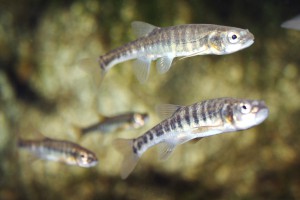 This is undoubtedly the widest-spread carp, with habitats spanning all Europe and North Asia, and down south to the catchment of the Amur, upstream Yalu and Northeastern Korea. It inhabits cold clean rivers and brooks, often jointly with trout and brook trout. This is one of the smallest species of the moderate zone, 8-9 cm long. Due to the small size, it rarely draws attention, although it is a very attractive fish easy to watch from shore or keep in a fish tank. Its coloration is motley, with big fuzzy spots on the sides placed more or less orderly. The background color is greenish with golden sheen on the flanks and silver sheen near the belly. In smaller specimens, the background is silvery, and a dark stripe runs lengthwise end of snout to base of caudal fin, where it ends in a black spot. Minnows are school fish with a habit of moving up the current, stopping in deeper spots of the stream; the larger species stick to the bottom, and the smaller ones to the surface. In some streams they are truly innumerable. One of the explanations is their omnivory. Minnows forage on diatoms, desmids and insect larvae, swallowing anything edible running through the water. When wind-pollinated trees and bush flower, minnows eat the pollen hitting the water, making it ripple the way it does in a particularly heavy rain.
This is undoubtedly the widest-spread carp, with habitats spanning all Europe and North Asia, and down south to the catchment of the Amur, upstream Yalu and Northeastern Korea. It inhabits cold clean rivers and brooks, often jointly with trout and brook trout. This is one of the smallest species of the moderate zone, 8-9 cm long. Due to the small size, it rarely draws attention, although it is a very attractive fish easy to watch from shore or keep in a fish tank. Its coloration is motley, with big fuzzy spots on the sides placed more or less orderly. The background color is greenish with golden sheen on the flanks and silver sheen near the belly. In smaller specimens, the background is silvery, and a dark stripe runs lengthwise end of snout to base of caudal fin, where it ends in a black spot. Minnows are school fish with a habit of moving up the current, stopping in deeper spots of the stream; the larger species stick to the bottom, and the smaller ones to the surface. In some streams they are truly innumerable. One of the explanations is their omnivory. Minnows forage on diatoms, desmids and insect larvae, swallowing anything edible running through the water. When wind-pollinated trees and bush flower, minnows eat the pollen hitting the water, making it ripple the way it does in a particularly heavy rain.
Spawning starts in spring at 7-10°С and lasts for a month or more. It is intermittent. Males turn strikingly spectacular in this season: their bodies shine green, dark spots become clearer, mouth corners turn maroon, and the belly turns magenta. The upper edge of the opercula and bases of the pectoral, pelvic and anal fins display bright white areas of horny epithelium, yellow pigment occurs behind the opercula and the pearly rash in the nape. The pearly rash – though somewhat thinner, as well as red in mouth corners is observed in females too. Males are smaller. Spawning takes place in rocky rifts, with roe sticking mostly to the underside of rocks. Minnow roe is easy to tell from roe of other resident fish (gudgeons and brook trout) by its larger size, transparent shell and the pinkish yolk. Minnows comprise part of diet for pike and eelpout fry.
/ * The photos at lake.peipsi.org are cross-posted from commons.wikimedia.org and are used for familiarization purposes only. No commercial use of the photos is allowed. For more information about to use the photos see the originals on commons.wikimedia.org. /


